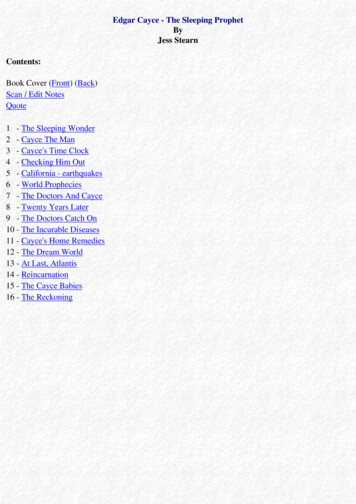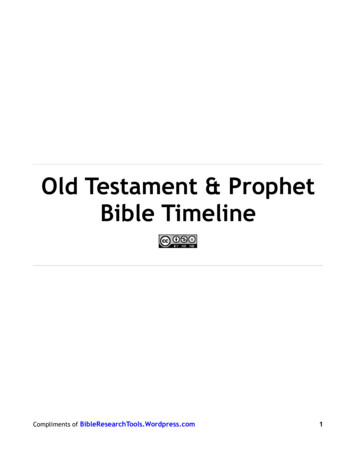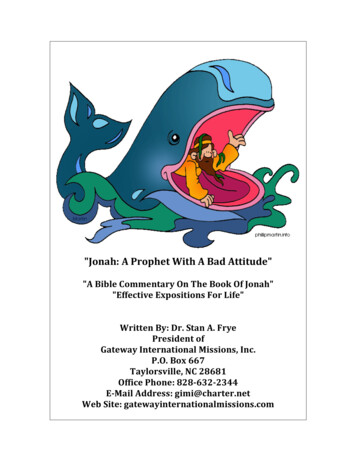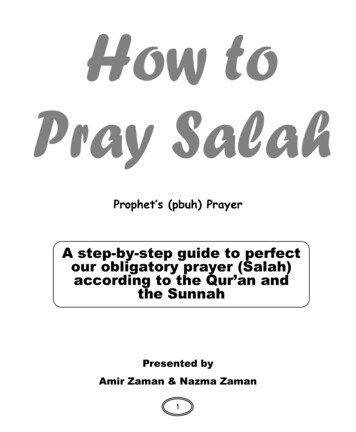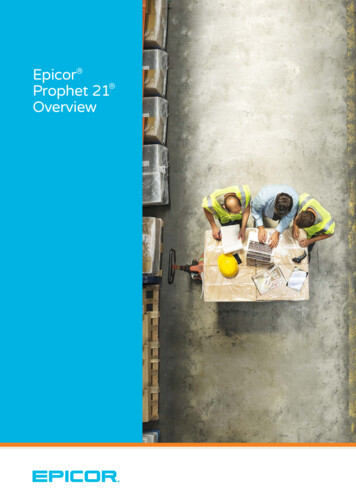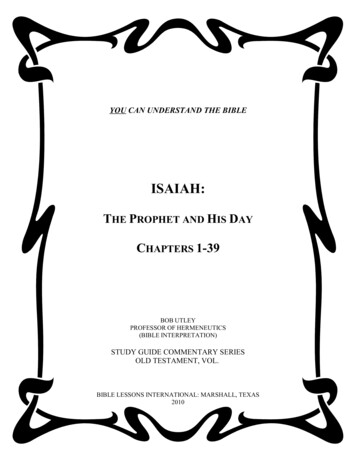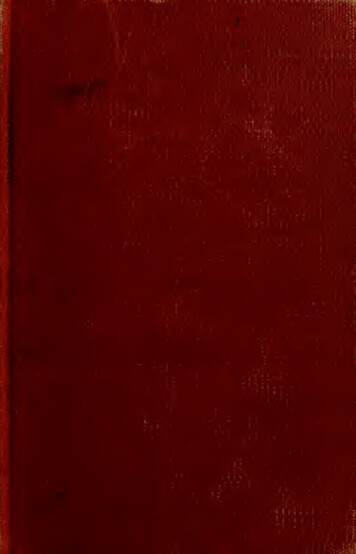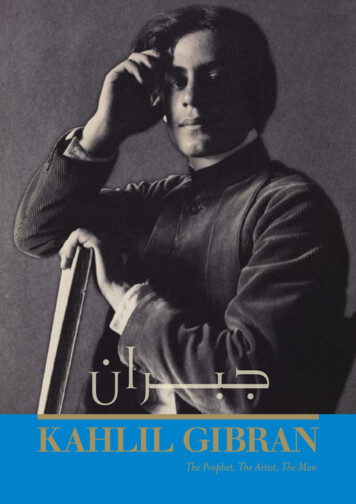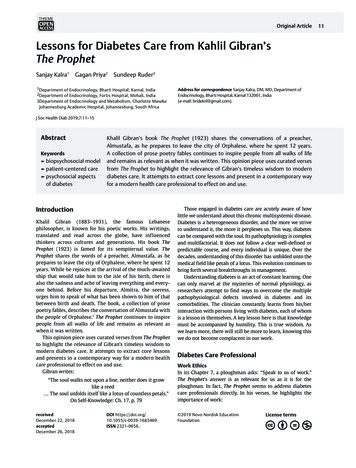
Transcription
Curriculum Guide
Curriculum GuideFor the FilmKahlil Gibran’s The ProphetJourneys in Filmwww.journeysinfilm.orgJourneys in Film: Kahlil Gibran’s The Prophet
Educating for Global Understandingwww.journeysinfilm.orgJourneys in Film StaffJoanne Strahl Ashe, Founding Executive DirectorEileen Mattingly, Director of Education/Curriculum Content SpecialistAmy Shea, Director of ResearchRoger B. Hirschland, Executive EditorEthan Silverman, Film Literacy ConsultantJourneys in Film Board of DirectorsJoanne Strahl Ashe, Founder and ChairmanErica Spellman SilvermanDiana BarrettJulie LeeMichael H. LevineAuthors of this curriculum guideJack BurtonAnne EnglesKathryn FitzgeraldJonathan Freeman-CoppadgeBengt JohnsonMatt McCormickLaura ZlatosWith thanks to Lynn Hirshfield and Hamida Rehimi of Participant Media,and to William Nix of Creative Projects Group and Executive Producer ofKahlil Gibran’s The ProphetCopyright 2015 Participant Media, LLC. All Rights Reserved.Participant Media331 Foothill Rd., 3rd FloorBeverly Hills, CA 90210310.550.5100www.participantmedia.comJourneys in Film50 Sandia LanePlacitas, NM 87043505.867.4666www.journeysinfilm.org
Table of ContentsIntroductionAbout Journeys in FilmA Letter From Liam NeesonIntroducing Kahlil Gibran’s The ProphetA Letter From Salma HayekNotes to the Teacher68101213LessonsLesson 1:Who Was Kahlil Gibran?(Art History, Philosophy, Social Studies, English Language Arts)15Lesson 2:The Art of Kahlil Gibran(Art, Art History)23Lesson 3:On Freedom(English Language Arts)32Lesson 4:On Children(English Language Arts)41Lesson 5:On Marriage(English Language Arts)47Lesson 6:On Work(English Language Arts)53Lesson 7:On Eating and Drinking(English Language Arts)62Lesson 8:On Love(English Language Arts)74Lesson 9:On Good and Evil(English Language Arts)80Lesson 10: On Death90(English Language Arts)Lesson 11: The Visual Imagery of Kahlil Gibran’s The Prophet98(Film Literacy)Journeys in Film: Kahlil Gibran’s The Prophet5
About Journeys in FilmJourneys in Film was founded in 2003 to use the storytell-Many teachers have reported that the Journeys in Filma richer understanding of the diverse and complex worldempathy and acceptance; their curiosity about the worlding power of film to educate our young generations towardprogram was beneficial to their students: Students gain inin which we live. Our goal is to help students develop abeyond their own cultural groups increases.deeper knowledge of global issues and current challenges.We aim to mitigate attitudes of cultural bias and racismand to cultivate human empathy and compassion. We striveto prepare students for effective participation in the worldeconomy as informed global citizens.In addition to the free film-based lesson plans, Journeys inFilm offers professional development to help teachers effectively use film as an instructional tool to motivate studentsin learning about and engaging with the world.Journeys in Film transforms entertainment media into edu-cational media by using feature-length, domestic and inter-national narrative and documentary films to engage studentsin active learning. Selected films are used as springboardsfor lesson plans in math, science, language arts, visual arts,and social studies, as well as on critical current topics:human rights, poverty and hunger, stereotyping, environ-mental sustainability, global health and pandemics, refugeeissues, gender roles, and the status of girls throughoutthe world. Prominent educators on our team consult withfilmmakers and cultural specialists in the development ofcurriculum guides. Each guide is dedicated to an in-depthexploration of the culture and issues depicted in a specificfilm. The guides merge effectively into teachers’ existinglesson plans and mandated curricular requirements, providing teachers with an innovative way to fulfill their schooldistricts’ standards-based goals.Our research supports the founding premise that film can beOur Middle School Program for Global UnderstandingTo be prepared to participate in tomorrow’s global arena,students need an understanding of the world beyond theirown borders. Journeys in Film offers innovative and engaging tools to explore other cultures and social issues, beyondthe often negative images seen in print, television, and filmmedia. For today’s media-centric youth, film is an appropri-ate and effective teaching tool. Journeys in Film has carefullyselected quality films that tell the stories of young peopleliving in locations that may otherwise never be experiencedby your students. Students travel through these charactersand their stories: They drink tea with an Iranian family inChildren of Heaven, play soccer in a Tibetan monasteryin The Cup, find themselves in the conflict between urbangrandson and rural grandmother in South Korea in The WayHome, and watch the ways modernity challenges Maori traditions in New Zealand in Whale Rider.a powerful ingredient in a school curriculum.6Journeys in Film: Kahlil Gibran’s The Prophet
Documentary Films on Contemporary andHistorical TopicsIn addition to our ongoing development of teaching guidesfor culturally sensitive foreign films, Journeys in Filmbrings other outstanding and socially relevant films to theclassroom. We have identified exceptional narrative anddocumentary films that teach about a broad range of socialissues in real-life settings such as famine-stricken andwar-torn Somalia, a maximum-security prison in Alabama,and a World War II concentration camp near Prague. Thecurriculum guides from Journeys in Film help teachers integrate these films into their classrooms, examining complexissues, encouraging students to be active rather than passiveviewers, and maximizing the power of film to enhance critical thinking skills and to meet the Common Core standards.Journeys in Film is a 501(c)(3) nonprofit organization and is a project of the USC Annenberg Norman Lear Center,a nonpartisan research and public policy center that studies the social, political, economic, and cultural impact ofentertainment on the world—and translates its findings into action.Journeys in Film: Kahlil Gibran’s The Prophet7
A Letter From Liam NeesonWorking in films such as MichaelBy using carefully selected foreign films that depict life inCollins and Schindler’s List, I’veother countries and cultures around the globe, combinedseen the power of film not onlywith interdisciplinary curriculum to transform entertainmentto entertain, but also to changemedia into educational media, we can use the classroom tothe way audiences see themselvesbring the world to every student. Our foreign film programand the world. When I first metdispels myths and misconceptions, enabling students to over-Joanne Ashe, herself the daughtercome biases; it connects the future leaders of the world withof Holocaust survivors, sheeach other. As we provide teachers with lessons aligned toexplained to me her vision for a new educational programCommon Core standards, we are also laying a foundation forcalled Journeys in Film: Educating for Global Understanding.understanding, acceptance, trust, and peace.I grasped immediately how such a program could transformthe use of film in the classroom from a passive viewingactivity to an active, integral part of learning.In addition to our ongoing development of teachingguides for culturally sensitive foreign films, Journeys inFilm has begun a curricular initiative to bring outstandingI have served as the national spokesperson for Journeys indocumentary films and popular feature films to the class-Film since its inception because I absolutely believe in theroom. Journeys in Film has identified exceptional narrativeeffectiveness of film as an educational tool that can teachand documentary films that teach about a broad range ofour young people to value and respect cultural diversity andsocial issues, in real-life settings such as an AIDS-strickento see themselves as individuals who can make a difference.township in Africa, a maximum-security prison in Alabama,Journeys in Film uses interdisciplinary, standards-alignedand a World War II concentration camp near Prague.lesson plans that can support and enrich classroom pro-Journeys guides help teachers integrate these films into theirgrams in English, social studies, math, science, and the arts.classrooms, examining complex issues, and maximizing theUsing films as a teaching tool is invaluable, and Journeys inpower of film to enhance critical thinking skills, a CommonFilm has succeeded in creating outstanding film-based cur-Core goal. I am particularly pleased that Journeys in Filmriculum integrated into core academic subjects.has developed this guide for Kahlil Gibran’s The Prophet.8Journeys in Film: Kahlil Gibran’s The Prophet
Please share my vision of a more harmonious world wherecross-cultural understanding and the ability to converseabout complex issues are keys to a healthy present and apeaceful future. Whether you are a student, an educator, afilmmaker, or a financial supporter, I encourage you to participate in the Journeys in Film program. (Journeys in Filmis a 501(c)(3) nonprofit organization.)Please join this vital journey for our kids’ future. They arecounting on us. Journeys in Film gets them ready for theworld.Sincerely,National SpokespersonJourneys in FilmJourneys in Film: Kahlil Gibran’s The Prophet9
Introducing the Film Kahlil Gibran’s The ProphetOn the imaginary island of Orphalese, the poet and artistfrom France, Dubai, Poland, Ireland, and the United StatesMustafa continues his writing and painting, despite beingdirected the animation, each with free rein to interpret andunder house arrest for many years. He is looked after byillustrate a poem. The animations, all very different fromKamila, a beautiful housekeeper, and Hakim, his friendlyeach other, nevertheless blend seamlessly into the mainguard. Kamila’s troubled, silent young daughter, Almitra,story.forms an unlikely friendship with Mustafa. When he isreleased from house arrest and ordered to leave the country, she trails along. On the way, Mustafa passes by a villagewedding, an outdoor café, and a marketplace. At each place,the poet is asked to share his wisdom with the townspeople.Immensely popular and revered by the townspeople, he isincreasingly perceived as a threat by the authoritarian government of Orphalese.Viewers of all ages will find much to admire in the film.Children will enjoy the adventures of the mischievous littleAlmitra and her equally mischievous seagull companion asthey perch on rooftops, share purloined snacks, and torment the mean and gluttonous Sergeant. Older studentsand adults will appreciate both the film’s humor and itspoignancy as they compare Orphalese with the repressiveregimes we know too well; they will acknowledge Mustafa’sThe film is inspired by Kahlil Gibran’s beloved book ofcourage as a man who, like the most devoted of today’spoetic essays, The Prophet, but there is so little plot in theactivists, values his principles even more than life itself.original story—just a man waiting for a ship and addressingKahlil Gibran’s The Prophet portrays the human soul’s tri-his followers, that producer Salma Hayek felt that addi-umph over oppression through beauty, art, music, friend-tional background, characterization, and events would makeship, loyalty, tolerance, and love.the film more accessible and more appealing to families.She and the other producers turned to writer and directorRoger Allers, best known for the Disney film The Lion King,to write the storyline and to give direction to the mainnarrative. With a setting that is deliberately ambiguous, theevents could happen anywhere in the Mediterranean, withmany characters modeled after people Allers met in Crete asa young man.Gibran was a man who believed strongly in unity in diversity. The way that the film Kahlil Gibran’s The Prophet wasconceived, financed, produced, and released, and the waythat animators from many countries and cultures unitedto illustrate this story, reflect Gibran’s view of the world,his idea that we are all part of a multifaceted culture anddesign.An animated narrative becomes a frame story in which marvelous and dreamlike animations are embedded. As Mustafadiscourses on love, marriage, work, and other major lifeissues, the child Almitra’s imagination soars and the vieweris engaged in fantastical and magical interludes that interpret the philosophical messages. Several different artists10Journeys in Film: Kahlil Gibran’s The Prophet
Director: Roger AllersProducers: Salma Hayek, Clark Peterson, José Tamez, and RonSenkowskiExecutive Producers: Steve Hanson, François Pinault, Jeff Skoll,Jonathan King, Julia Lebedev, Leonid Lebedev, Naël Nasr, HaythamNasr, Jean Riachi, Julien Khabbaz, and William NixCast: Liam Neeson, Salma Hayek, Quvenzhané Wallis, JohnKrasinski, Frank Langella, and Alfred MolinaAnimation Directors:Michal Socha, On Freedom (Poland)Nina Paley, On Children (United States)Joann Sfar, On Marriage (France)Joan Gratz, On Work (United States)Bill Plympton, On Eating and Drinking (United States)Tomm Moore, On Love (Ireland)Mohammed Saeed Harib, On Good and Evil (Dubai/France)Paul and Gaetan Brizzi, On Death (France)Art Director: Bjarne HansenComposer: Gabriel YaredAdditional Music by Lisa Hannigan, Glen Hansard, and Damien RiceSpecial Performance by Yo-Yo MaRunning length: 84 minutesAwards: Nominated for World Soundtrack Award, Composer of theYear—Gabriel YaredJourneys in Film: Kahlil Gibran’s The Prophet11
A Letter From Salma HayekThe first time I ever saw the bookPHOTOGRAPHER: GEORGES BIARDThe Prophet, by Kahlil Gibran,I was not even six years old. MyLebanese grandfather kept it byhis bedside. I was too young toread it, but I understood that itwas a little treasure for him, and Iwas intrigued by its contents andthe drawing of the mysterious man on its cover.It wasn’t until my late teens that I actually experienced itsbeauty and power, and for many years I have continued todo so because every time I read it, I experience it in a completely different way. It magically takes my mind into newplaces that I thought I already knew. Gibran’s words moveme in an intimate way, and have done so for millions of people. The book has sold more than 100 million copies aroundthe world, and it’s one of the most beloved books ever.In an effort to celebrate Kahlil Gibran’s writings, we havecreated a film that visually and musically takes you on anadventure into his poetry and wisdom. So, on behalf ofeveryone involved in making this film, we invite you toexplore the film and the book, and to discover for yourselfthe joy of Kahlil Gibran’s world.Salma Hayek12Journeys in Film: Kahlil Gibran’s The Prophet
Notes to the TeacherIf [the teacher] is indeed wise he does not bid you enter the house of his wisdom,but rather leads you to the threshold of your own mind.— Kahlil GibranThese words, from a poem by Kahlil Gibran called “Onwith a survey of some of his paintings demonstrating howTeaching,” exhort teachers to practice humility and chal-the film’s embedded animations reflect the influences of thelenge us: How do we lead our students to the thresholdsauthor’s visual style.of their own minds? This curriculum guide will help youachieve that goal by introducing lessons that encourage bothcritical thinking and creativity.The eight shorter English language arts lessons focus onthe poems and dreamlike animation sequences embeddedin the story of Almitra and the poet Mustafa. Each lessonKahlil Gibran’s The Prophet is a film that appeals to studentsis designed in three parts, so that students can analyze theof all ages. The lessons in this guide will help you to use thepoem, review important terms for the study of poetry, andfilm in the classroom to further your curricular goals. Theyproduce their own creative writing. The content and objec-have been developed by experienced classroom teachers andtives of each lesson determine the order in which these threeare aligned with Common Core State Standards. The lessonsparts are presented.may be taught as a unit, or individual lessons may be usedindependently.Finally, there is a film literacy lesson that teaches students tolook at not just a film’s message, but also how it conveys itsThe opening lesson introduces students to Kahlil Gibran’s lifemessage. Students learn to use a contemporary film vocab-and philosophy. As a Lebanese-born adolescent, he moved toulary that is more usually applied to live-action films, as athe United States, where he first learned English. He returnedway of analyzing directorial choices in animation.to his native land for Arabic studies and, finally, continuedhis artistic education in Paris, becoming a true cosmopolitanfigure. Gibran’s 1923 book, The Prophet, universally knownand loved, has sold more than 100 million copies and hasbeen translated into more than 50 languages.The film Kahlil Gibran’s The Prophet and the accompanyingcurriculum guide may be used independently or in conjunction with the study of the book The Prophet in world literature, American literature, poetry, creative writing, and evenAdvanced Placement literature classes. It is important thatAlthough best known as a writer, Gibran was also a visualstudents understand the textual differences between the orig-artist who took pride in designing and illustrating all hisinal book and the film. Almustafa, “the chosen and beloved,”books. The second lesson in the curriculum gives studentsthe “prophet” in the original book, becomes in the film theinsight into the artistic traditions that influenced his work,character Mustafa, a poet. Similarly, in the book, Almitra is aJourneys in Film: Kahlil Gibran’s The Prophet13
“seeress” or mystical figure, not the film’s mischievous younggirl. And in the original text, repressive state officers do notthreaten and exile Almustafa; he simply awaits the arrival ofhis ship. Gibran’s exact words have occasionally been editedAdditional l-gibranBiography of Kahlil Gibran and a list of his writingsfor the eight poems presented in the film. It may be valuablehttp://www.gibrankhalilgibran.org/Home/for students to explore more completely the 28 poems of theA gallery of paintings owned by the Gibran Nationaloriginal text.Committee (in Lebanon).Several lessons suggest showing the full film Kahlil il-gibran/The Prophet in one sitting. If you are teaching the entireEnglish translations of essays on the life of Gibran Kahlilunit, you should decide whether to show it once or severalGibran, Lebanon His Motherland, Academic Review,times. The film clips of the embedded animations used inUnpublished Texts and a Catalogue of original art and pho-the lessons are indicated by starting and stopping numbers.tos from Gibran el Profeta. Museo Soumaya, Carlos SlimPlease note that these are approximate, depending on yourFoundation, Mexico City, Mexico. 2009.specific version of the film. Some clips include a bit of themain story because the poem recitation begins before theanimation or continues after it. Take the time to set up yourprojection method before the class begins and bookmarkBushrei, Suheil B., and Joe Jenkins. Kahlil Gibran, Manand Poet: A New Biography. Oxford, England: OneworldPublications, 1998. Print.the clip you wish to use so that you can integrate the filmGibran, Jean, and Kahlil Gibran, Kahlil Gibran, His Lifeclip smoothly into your instruction. New and used printedand World, first published New York Graphic Society, Ltd.,copies of The Prophet are readily available in bookstores and1974. Updated and revised with Foreword by Salma Khadralibraries, and over the Internet. A new paperback edition isJayyusi, Interlink Publishing Group, 1991. Scheduled fordue for release in conjunction with the release of the filmrevision, Interlink Publishing Group, 2015. Print.Kahlil Gibran’s The Prophet.Waterfield, Robin, Prophet: The Life and Times of KahlilGibran. New York: Penguin Books, 1998. Print.14Journeys in Film: Kahlil Gibran’s The Prophet
Lesson 1(ART HISTORY, PHILOSOPHY, SOCIAL STUDIES,ENGLISH LANGUAGE ARTS)Who Was Kahlil Gibran?Enduring Understandings Kahlil Gibran’s early experiences shaped his beliefs inmaturity. In his poetry and spirituality, Gibran often reconciledapparent opposites in a higher unity. The courage to stand alone and stand out gave Gibranhis unique, powerful, timeless voice.Notes to the TeacherKahlil Gibran’s life is a model for our increasingly global world.Born in Lebanon, he came to the United States at the age of 12,attending school in Boston and later in Beirut and Paris beforemoving to New York City. He adapted quickly to Americanculture, but retained his love for his homeland, second only tolove for a spiritual, transcendent view of mankind. He wrotein both English and Arabic; his work shows elements of manyreligious faiths and great understanding of their commonalities. This lesson will familiarize students with his life and hisEssential Questions How did Gibran serve as a bridge between periods,places, and cultures? Why is there such a wistful sadness in so many placesin Gibran’s writings? What is the relationship between Gibran’s visual artand written work?belief in our essential human unity; it will ask them to theorizeabout some of the many ways that Gibran’s work is so relevantto today’s divided world.Gibran was born on January 6, 1883, to a Maronite Catholicfamily in Bsharri, in what is now northern Lebanon. Gibranhad an older half-brother named Peter, and two youngersisters, Mariana and Sultana. When Gibran was eight yearsold, his father was sent to prison for tax evasion, and thefamily lost their home and had to go to live with relatives.Gibran’s mother, Kamila, soon decided that they shouldleave for the United States, following a cousin who had leftearlier. Gibran’s father, after being released from prison,remained behind in Lebanon.According to Ellis Island records, Gibran, with his motherand siblings, arrived in New York City on June 17, 1895.The family settled in Boston, which at the time had the second-largest Lebanese and Syrian communities in the UnitedStates, after New York. At school, Gibran was placed in a classfor immigrant children who needed to learn English, and hisname was altered from Gibran Khalil to Kahlil Gibran.Copyright 2015 Participant Media, LLC. All Rights Reserved.Journeys in Film: Kahlil Gibran’s The Prophet15
Gibran’s story is a good example of the immigrant experi-Gibran died in 1931 in New York at the age of 48.ence in the United States around the turn of the century. HeAccording to his wishes, he was buried in his hometown ofwas invited to be involved in the Dennison House, a localBsharri in Lebanon, where a museum has been developedcommunity center, or “Settlement House,” an institutionaround his gift of the contents of his studio.that helped many immigrants in large cities to learn English,understand American ways, care for their children, andbecome adjusted to life in the United States—starting toachieve what became known as “the American Dream.”The lesson consists of three parts. Near the end of the filmKahlil Gibran’s The Prophet, the Pasha of Orphalese readsaloud Mustafa’s words about nations and demands that herenounce them or be put to death. Mustafa refuses, and willIt was through this involvement that his drawings attractedeventually face the firing squad. Interestingly, the wordshis teachers’ attention. He was introduced to Fred Hollandquoted by the Pasha are not to be found in the book TheDay, a well-known publisher and talented photographerProphet, but in a later work, The Garden of the Prophet.who expanded the young immigrant’s cultural horizons andThe tempo of the lines in this latter work have a biblicalencouraged and supported his artistic aspirations. In 1903cadence, as in a prophet scolding Israel, or Jesus warningthe poet Josephine Preston Peabody sponsored Gibran’sthe hypocrites of his age with a repeated series of “Woe tofirst solo art exhibition at Wellesley College. A year lateryou .” The first part of this lesson asks students to studyDay held an exhibit of Gibran’s works at Boston’s Harcourtthe longer writing from which the filmmakers excerpted theStudios, where the 21-year-old artist met Mary Elizabethpassage for which Mustafa was condemned and to deter-Haskell, the headmistress of a girls’ school; her finan-mine its relevance to the contemporary world.cial patronage and personal support would prove crucialthroughout his career. From 1908 to 1910, he studied art inParis and in 1912 he settled back in New York, in the 10thStreet Studios in Greenwich Village, where he devoted himself to painting and writing.The second part of the lesson involves another Gibranwork, one in which he took a larger perspective than that ofnationalism, closer to what we now call “global citizenry,”or what Gibran often called “cosmopolite.” His spiritualviews insisted on the deep and abiding unity of all human-Gibran’s early works were written in Arabic, but from 1918kind, despite the fact that people come from many diverseon he published mostly in English—although he did con-races, religions, languages, and countries. His beliefs weretinue to write in Arabic, mostly on political or cultural sub-triggered by certain aspects of the conflicts of World War Ijects relating to the Arab world. Gibran’s masterpiece, Theand the tragic history of Lebanon, a country that had suf-Prophet, was published in 1923. Kahlil Gibran, The Collectedfered from internal sectarian strife, conflicts with neighbors,Works, published by Everyman’s Library in 2007, containsand control of its destiny by outside powers. In this part of12 of his major English books; they were originally pub-the lesson, students read Gibran’s poem “A Poet’s Voice”lished in the United States by Alfred A Knopf.and consider its value in the contemporary world.16Journeys in Film: Kahlil Gibran’s The Prophet
Lesson 1(ART HISTORY, PHILOSOPHY, SOCIAL STUDIES,ENGLISH LANGUAGE ARTS)The conclusion of the lesson considers Gibran’s biography,although, as Gibran might argue, his thoughts and workare more important and enduring than the incidentals ofhis personal life. Students research the facts and events ofGibran’s personal life and career and then draw conclusionsabout how they might have influenced his philosophy.For additional information about Kahlil Gibran’s life, seeMaterialsPhotocopies of Handouts 1–3Gibran’s poem “A Poet’s Voice” from Tears and aSmile, also known as Tears and Laughter, translated by H. M. Nahmad. New York: Knopf 1948. Itcan be found in Kahlil Gibran: The Collected Works,Everyman’s Library 2007).the following websites:Pen or ibran#poetJournal or ography/Student Internet ran-kahlil-gibran/notas-biograficas/Duration of the LessonTwo or three class periodsAssessmentClass discussionsJournal entriesCompletion of Handouts 2 and 3Journeys in Film: Kahlil Gibran’s The Prophet17
Procedureviews expressed by Almustafa? Which of his statementsPart 1: “Pity the Nation”prove to be a challenge, a help, or a threat to leaders of1. Pass out Handout 1: “Pity the Nation.” Have studentsread the poem aloud, one line at a time, going arounddo you agree or disagree with? Why? Would his viewsnations today? What would Almustafa say if he looked atour contemporary world?the class to involve many students.2. Ask if there are any questions on the basic meaning ofthe words and phrases; Gibran writes with a traditionalPart 2: Exiles as Global Citizens1. Start the class with a journal-writing assignment for fivelinguistic structure that often echoes the style of the Kingto seven minutes as a warm-up, using the followingJames Bible.prompts:3. Divide the class into seven small groups and assign eacha. What do we mean when we talk about our rela-group one of the lines that includes the phrase “Pity thetionship with our native land, the country of ournation.” Explain to students that they are going to takebirth, our homeland? How does such a relationshipapart and analyze each line and present their interpreta-develop?tions to the class. They will need to brainstorm answersto each of the questions on the handout and fully discussthem. Tell them that they should record their answers tothe questions.4. Give the small groups approximately 20 minutes to workon these three questions, writing their ideas and answersin their journal or notebook. Visit the groups to encourage them and stimulate their thinking, especially perhapswith the brainstorming of historical examples.5. Bring the class back together and have someone fromb. What does it mean to be an exile?c. Are there any positive aspects to being an exile?2. Hold a class discussion about the students’ responses tothe journal prompts. (Be particularly sensitive to students who have come from other countries.)3. Share the following information with the class: Thewriter Vera Linhartova, an exile from the former nationof Czechoslovakia, said that exile sends one “towardanother place, an elsewhere, by definition unknowneach of the groups share the group’s findings and think-and open to all sorts of possibilities . The writer ising about the questions.above all a free person, and the obligation to preserve6. To conclude, ask them to consider all the answers thatthey have heard during the reports. Hold a discussionaround questions like these: What do you think of the18his independence against all constraints comes beforeany other consideration. And I mean not only the insaneconstraints imposed by an abusive political power, butthe restrictions—all the harder to evade because theyJourneys in Film: Kahlil Gibran’s The P
Kahlil Gibran’s The Prophet portrays the human soul’s tri-umph over oppression through beauty, art, music, friend-ship, loyalty, tolerance, and love. Gibran was a man who believed strongly in unity in diver-sity. The way that the film Kahlil Gibran’s The Prophet was
